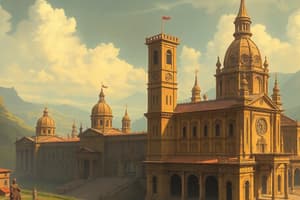Podcast
Questions and Answers
В эпоху Возрождения художники обратились к греческой и римской ________ для вдохновения
В эпоху Возрождения художники обратились к греческой и римской ________ для вдохновения
скульптуре
Ренессансные художники черпали вдохновение из греческой и римской ________ для создания более реалистичных образов людей
Ренессансные художники черпали вдохновение из греческой и римской ________ для создания более реалистичных образов людей
живописи
В Ренессансе техники классического искусства гармонично сочетались с фокусом на человеческой красоте и ________
В Ренессансе техники классического искусства гармонично сочетались с фокусом на человеческой красоте и ________
природе
Поддержка патронов сыграла ключевую роль в развитии ренессансного искусства, с богатыми личностями, присоединившимися к католической ______, в заказе произведений искусства
Поддержка патронов сыграла ключевую роль в развитии ренессансного искусства, с богатыми личностями, присоединившимися к католической ______, в заказе произведений искусства
Первоначально католическая церковь заказывала большинство произведений искусства в средние века, но богатые личности также стали важными ________ в Ренессансе
Первоначально католическая церковь заказывала большинство произведений искусства в средние века, но богатые личности также стали важными ________ в Ренессансе
Семья Медичи во Флоренции поддерживала многих известных художников, таких как Микеланджело, Боттичелли, Леонардо да Винчи и Рафаэль
Семья Медичи во Флоренции поддерживала многих известных художников, таких как Микеланджело, Боттичелли, Леонардо да Винчи и Рафаэль
Flashcards are hidden until you start studying
Study Notes
Renaissance Period
Art
During the Renaissance, artists turned to Greek and Roman sculpture, painting, and decorative arts for inspiration. Techniques from classical art meshed well with the Renaissance's focus on human beauty and nature. Advancements in perspective, light, and shadow helped artists create more lifelike images. Patron support played a crucial role in the development of Renaissance art, with wealthy individuals joining the Catholic Church in commissioning artwork.
Impact of Classical Art on Renaissance Art
Classical art significantly influenced Renaissance art through the use of human beauty and nature. Renaissance artists drew inspiration from Greek and Roman sculpture, painting, and decorative arts to create more realistic images of people living life with emotions. The focus on the individual and the natural world was reflected in this art form during the period.
Patronage of Renaissance Art
Patrons played a significant role in the growth of Renaissance art by providing financial support for successful artists to develop new techniques and styles. Initially, the Catholic Church commissioned most artwork during the Middle Ages, but wealthy individuals also became important patrons in the late 14th through early 16th centuries. The Medici family in Florence supported many notable artists such as Michelangelo, Botticelli, Leonardo da Vinci, and Raphael. Florence served as the initial epicenter of Renaissance art, with Rome taking over towards the end of the 15th century when Pope Leo X (a Medici) filled the city with religious buildings and art. This high point is known as the High Renaissance, lasting from the 1490s to the 1520s.
Science
The Renaissance marked a significant shift in scientific discovery, shifting the focus from abstract theories to empirical observation. Advances were made in various fields, including geography, astronomy, chemistry, physics, mathematics, manufacturing, anatomy, and engineering. The invention of printing technology greatly facilitated the propagation of scientific ideas.
Geographical Exploration
The Renaissance era saw increased exploration, challenging the limitations set by Ptolemaic geography. For instance, Christopher Columbus challenged the notion of a finite European world.
Impact of Printing on Sciences
Printing played a pivotal role in advancing science during the Renaissance. It facilitated the distribution of knowledge, allowing scholars to access the works of other scientists and share their findings.
Literature
Renaissance literature centered around humanist themes and was characterized by a return to the classical ideals of tragedy and comedy. Shakespeare's works, such as "Hamlet," exemplify this trend. The printing press enabled popular plays to be published and redistributed across Europe and beyond.
Humanist Themes in Renaissance Literature
Renaissance literature embraced humanist themes such as human agency, the non-religious meaning of life, and the true nature of man. Shakespeare's "Hamlet" showcases these characteristics as an educated Renaissance man.
The Printing Press Impact on Literature
The printing press made literature more accessible to a wider audience by facilitating the dissemination of popular plays across Europe and beyond. This allowed for the sharing of ideas and the exchange of literary works.
Architecture
Renaissance architecture was influenced by classical Roman temple architecture, characterized by centralized domes and vaults receding into space. Buildings were designed with mathematical precision to create harmony between form and function. Both Florence and Rome served as epicenters for the development of Renaissance architecture.
Humanistic Studies in Architecture
The focus on humanism guided the architectural innovations during the Renaissance, leading to buildings that emphasized rational planning and proportion. These structures aimed to reflect the ideals of balance, order, and clarity.
Centralized Domes and Vaults
Centralized domes and vaults were key features of Renaissance architecture, inspired by classical Roman temple designs. They offered a sense of harmony and stability in their construction, reflecting the period's emphasis on mathematical precision.
Philosophy
Philosophical thought during the Renaissance was characterized by a revival of classical learning and a more individualistic view of man. Renaissance thinkers sought wisdom by studying the natural world to gain insights into human existence.
Revival of Classical Learning
The Renaissance marked a resurgence of interest in classical texts, particularly those concerning ethics, logic, metaphysics, and epistemology. These studies provided a foundation for the development of new philosophical concepts during the period.
Individualism in Philosophy
The emphasis on individualism during the Renaissance influenced philosophical thought, leading to explorations of personal identity and selfhood. This shift allowed for a deeper understanding of human nature and created room for questioning established beliefs.
Studying That Suits You
Use AI to generate personalized quizzes and flashcards to suit your learning preferences.




